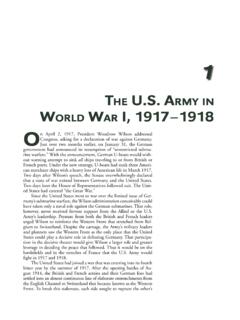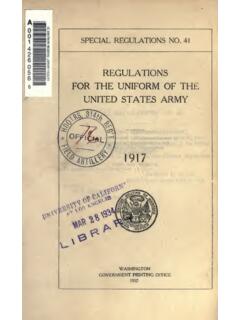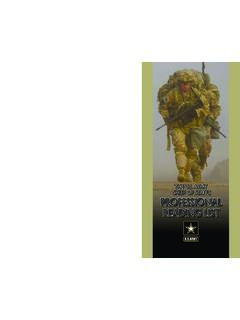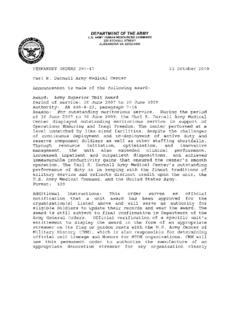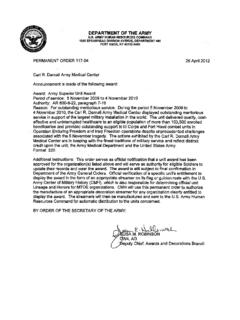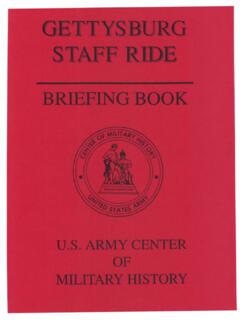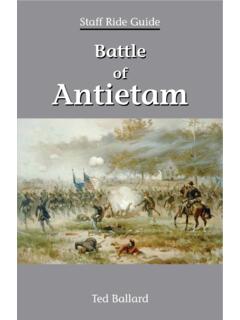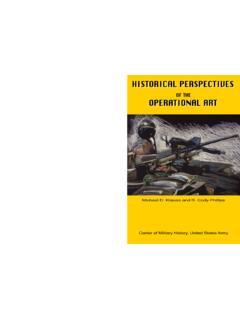Transcription of The Gettysburg Campaign, June-July 1863
1 The Army Campaigns of the Civil War The Gettysburg Camp ign june july 1863 . Cover: Scene from the Gettysburg Cyclorama painting, The Battle of Gettysburg , by Paul Phillippoteaux, depicting Pickett's Charge and fighting at the Angle. Photograph Bill Dowling, Dowling Photography. CMH Pub 75 10. The Gettysburg Camp ign june july 1863 . by Carol Reardon and Tom Vossler Center of Military History United States Army Washington, , 2013. Introduction Although over one hundred fifty years have passed since the start of the American Civil War, that titanic conflict continues to matter. The forces unleashed by that war were immensely destruc- tive because of the significant issues involved: the existence of the Union, the end of slavery, and the very future of the nation.
2 The war remains our most contentious, and our bloodiest, with over six hundred thousand killed in the course of the four-year struggle. Most civil wars do not spring up overnight, and the American Civil War was no exception. The seeds of the conflict were sown in the earliest days of the republic's founding, primarily over the existence of slavery and the slave trade. Although no conflict can begin without the conscious decisions of those engaged in the debates at that moment, in the end, there was simply no way to paper over the division of the country into two camps: one that was dominated by slavery and the other that sought first to limit its spread and then to abolish it. Our nation was indeed half slave and half free, and that could not stand. Regardless of the factors tearing the nation asunder, the soldiers on each side of the struggle went to war for personal reasons: looking for adventure, being caught up in the passions and emotions of their peers, believing in the Union, favoring states' rights, or even justifying the simple schoolyard dynamic of being convinced that they were worth three of the soldiers on the other side.
3 Nor can we overlook the factor that some went to war to prove their manhood. This has been, and continues to be, a key dynamic in understanding combat and the profes- sion of arms. Soldiers join for many reasons but often stay in the fight because of their comrades and because they do not want to seem like cowards. Sometimes issues of national impact shrink to nothing in the intensely personal world of cannon shell and mini ball. 5. Whatever the reasons, the struggle was long and costly and only culminated with the conquest of the rebellious Confederacy, the preservation of the Union, and the end of slavery. These campaign pamphlets on the American Civil War, prepared in commemoration of our national sacrifices, seek to remember that war and honor those in the United States Army who died to preserve the Union and free the slaves as well as to tell the story of those American soldiers who fought for the Confederacy despite the inherently flawed nature of their cause.
4 The Civil War was our greatest struggle and continues to deserve our deep study and contemplation. RICHARD W. STEWART. Chief Historian 6. The Gettysburg campaign june july 1863 . Strategic Setting After the Confederates' victory at Chancellorsville in May 1863 , General Robert E. Lee's Army of Northern Virginia and the Army of the Potomac, commanded by Maj. Gen. Joseph Hooker, once again confronted each other across the Rappahannock River near Fredericksburg, Virginia. The battle, which cost Hooker nearly 16,000 casualties and Lee some 12,300 losses, had proved indecisive. The two armies maintained an uneasy stalemate, occupying virtually the same ground they had held since December 1862. Washington, , the capital, stood fifty-three miles to the north, while Richmond, Virginia, the Confederate capital, lay fifty-seven miles to the south.
5 The rival presidents, Abraham Lincoln and Jefferson Davis, pondered their next moves. Despite the defeat at Chancellorsville and mounting discontent on the Northern home front, Lincoln could take heart from recent developments in the west. In April 1863 , Maj. Gen. Ulysses S. Grant shifted 20,000 Union troops from the west bank of the Mississippi River to the east bank, about thirty-five miles below the Confederate garrison at Vicksburg, Mississippi. From 1 to 17 May, Grant's command defeated Confederate forces at Port Gibson, Raymond, Jackson, Champion Hill, and the Big Black River Bridge. By the end of the month, Grant had trapped Lt. Gen. John C. Pemberton's 30,000 Confederates inside their fortifications around Vicksburg. After two unsuccessful frontal 7.
6 Assaults, Grant's army settled into a siege; meanwhile, a Confederate relief force under General Joseph E. Johnson failed to rescue Pemberton. Davis confronted a more daunting set of problems than his Northern counter- part. Amid bad news from Vicksburg and other parts of the Confederacy, he summoned Lee to Richmond twice in mid-May to discuss their stra- tegic options. Despite Lee's victory at Chancellorsville, the military situation in Virginia General Longstreet by Alfred R. appeared to be deteriorating. In Waud (Library of Congress). the Tidewater region, a Federal garrison of some 20,000 men General Lee (Library of Congress). held Suffolk, and their presence threatened both Norfolk and Hampton Roads. Given the size and location of the Federal force, Davis and Lee also feared for the safety of Richmond.
7 On 16 February 1863 , Lee had ordered the infantry divi- sions of Maj. Gens. John Bell Hood and Lafayette McLaws to march from the army's winter camp at Fredericksburg to Richmond and Hanover Junction. Two days later, Lee ordered Lt. Gen. James Longstreet to take command of the Suffolk Expedition, as he called it. On 21 March, Lee advised Longstreet to remain alert for an opportunity of dealing a damaging blow, or of driving [the enemy ] from any 8. important positions. Should Longstreet find such an opening, Lee urged him not to be idle, but act promptly.. Bad news on nearly all military fronts above all, the report that Grant had trapped Pemberton's army inside Vicksburg's defenses forced the Davis administration to consider a wide range of options. No single course of action could resolve all the challenges facing the president.
8 In addition to Vicksburg and Suffolk, Davis also had to consider impending Union offensives in middle Tennessee and at Charleston, South Carolina. Lee had, in fact, already crafted a plan for his own army. In early April, he advised Confederate Secretary of War James A. Seddon: Should General Hooker's army assume the defensive, the readiest method of relieving pressure on [Vicksburg and Charleston] would be for this army to cross into Maryland. One week later, Lee suggested to Davis: I think it all important that we should assume the aggressive by the first of May when we may expect General Hooker's army to be weakened by the expiration of the term of service of many of his regiments.. I believe greater relief would in this way be afforded to the armies in middle Tennessee and on the [South] Carolina coast than by any other method.
9 During his mid-May deliberations with Davis and Seddon, Lee continued to advocate an offensive operation against Hooker's army. He hoped to take the Army of Northern Virginia north of the Potomac once again. Lee's reverse at Antietam in September 1862. did not deter him from making a second northern expedition. While in winter camp in February 1863 , Lee had directed Jedediah Hotchkiss (then Lt. Gen. Thomas J. Stonewall Jackson's chief engineer) to draw up a map of the valley of Virginia extending to Harrisburg, PA and then on to Philadelphia wishing the prepara- tion to be kept a profound secret.. Not everyone who participated in the strategic conference in Richmond agreed with Lee's plan. A number of senior Confederate officials including Postmaster General John H.
10 Reagan and, for a time, even Davis himself advocated sending all or part of Lee's army to Mississippi. In the end, however, Lee's views won out. Davis gave his approval for the Army of Northern Virginia's invasion of the North. Only one question remained: When should the campaign begin? 9. Operations The Advance into Pennsylvania Lee issued his initial orders for the northern offensive on 3 june , stealthily breaking contact with Hooker's Army of the Potomac near Fredericksburg to concentrate around Culpeper. Despite Lee's best efforts, Hooker discovered that the Confederates were marching northward on 5 june . Hooker sent a force of 7,000. cavalry and 4,000 infantry and artillery under his new cavalry commander, Maj. Gen. Alfred Pleasonton, in pursuit of the Confederates.
